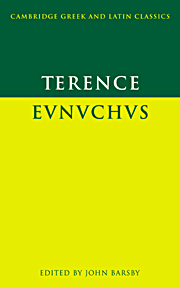Appendices
Published online by Cambridge University Press: 05 June 2012
Summary
METRE AND SCANSION
1. Basic principles
(a) Long and short syllables
Latin verse is quantitative, i.e. it is based on sequences of ‘long’ (-) and ‘short’ (∪) syllables, the convention being that a long syllable takes twice as long to pronounce as a short one. A syllable which ends in a consonant is ‘closed’ and is by definition long; one which ends in a vowel is ‘open’ and will be long if the vowel is long (or a diphthong) and short if the vowel is short. The basic rules for syllable division are: (i) a single consonant between two vowels belongs to the following syllable, leaving the preceding syllable open (mā-ter, mă-gis); (ii) where two consonants occur in succession, the first belongs to the preceding syllable and closes it (māg-nus); (iii) however, as an exception to (ii), where the two consonants are a ‘mute–liquid’ combination (such as cr, tr, pl), both generally belong to the following syllable (pă-trem). These principles apply not only within individual words but continuously between words within the line of verse: thus the syllable division of quid igitur faciam is quĭ-di-gĭ-tūr-cĭ-ām.
(b) Elision
Where one word ends with a vowel (or m, which is a mark of nasalisation) and the following word begins with a vowel (or h, which is a mark of aspiration), the first vowel is ‘elided’ so that the syllable loses any metrical value (si me obsecret = si m(e)ob-se-cret, quom accersor = qu(om)ac-cer-sor, siquidem hercle possis = si-qui-d(em)her-cle pos-sis).
- Type
- Chapter
- Information
- Terence: Eunuchus , pp. 290 - 311Publisher: Cambridge University PressPrint publication year: 1999

